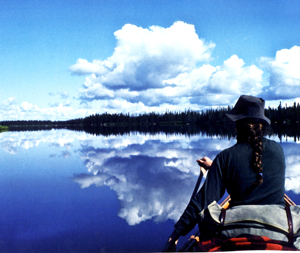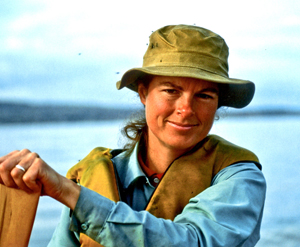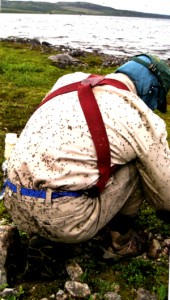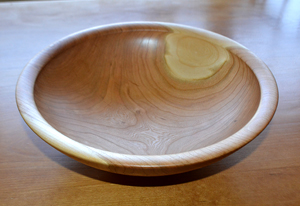

copyright the Chronicle June 11, 2014
by Bethany M. Dunbar
For those who love the wilderness, northern Quebec and Labrador are close enough to be enticing. On Northern Waters, by Dave Brown of Craftsbury, will take you there vicariously if the complications of backwoods canoe travel seem daunting. Watch out — it might spark the desire to experience these far northern places into an overwhelming craving. Mr. Brown hopes so.
The large format (11 by 13 inches) hardcover book is a collection of photos of 40 years of such trips, with an essay for each chapter. Mr. Brown created the book himself in the same way he creates wooden bowls, his home, and his furniture. He figured out how it was done, and then he did it, with quality as a goal instead of quantity.

The book is self-published and printed by an online company called Blurb. Each copy is $107. His main goal for the project was to have a gift for 20 friends, family members, and companions who have traveled with him, and for himself. He doesn’t expect very many sales to other people. Blurb prints each copy on demand, so there is no stack of unsold books in his house. But anyone can take a close look at his work by previewing it on the Blurb website.
Mr. Brown decided from the start that carrying a good camera with him for each trip was a priority. When he started these trips he took a film camera with slide film. When it came time to choose photos for the book, the first step was scanning 600 slides. Eventually, Mr. Brown chose 200 of them for the book. In his home are 12 feet of shelves, holding three-ring binders filled with all the slides, maps, and journal notes from his annual trips.
Many of the photos Mr. Brown chose for the book are simply there to show what the trip was like, who went, and what fish they caught. Others are breathtaking scenery. These are dramatic works of art.
On Northern Waters is also a record of a place that might not remain pristine forever.

“The Canadian north is changing rapidly with the ongoing search for minerals and the demands for more hydro development,” Mr. Brown writes in his introduction. “Valuable deposits of rare earth elements have been found recently just east of Indian House Lake along the Quebec/Labrador border. An extensive mine complex has been constructed at Voisey’s Bay along the Labrador coast since our first visit to that area. The George River caribou herd has declined drastically in the last 20 years for reasons that are unclear. The recent designation of some areas as national parks, while preserving them from development, has imposed some restrictions on access and travel. I feel incredibly fortunate to have traveled as extensively as we have, to have enjoyed water safe to drink directly from the rivers and lakes and fish safe to eat without concern for contamination and to have seen hundreds of caribou flowing across the land and water. It is somewhat ironic that the 350-mile long railroad line built to transport iron ore from one of the largest open pit mines in the world and the road built in conjunction with one of the largest hydroelectric projects are developments that have allowed us to access these otherwise remote areas in an affordable way.”
A photo of the George River headwaters shows a raw, undefined pattern of waters and woods as far as the eye can see. These are not lakes or rivers exactly. Instead they look like a giant bog quite possibly approximating the size of Texas. The tangled waterways extend as far as the horizon, and beyond what one can see from this one aerial photo.

A photo of Mr. Brown and his friend C.W. Russell on the Nipisso River in Quebec in 1977 says it all. The two have climbed up from the riverbank to a rocky outcrop and are gazing into the sky. In the background is the river and an outcrop on the other side. Trees, rocks, water, and a couple of guys.
This is country with huge waterfalls around the bend here and there, and no guidebooks. Those who travel in these northern waters have to know how to prepare for whitewater and decide if it’s safe to canoe through it or if it must be walked through with lines on the boats or portaged around. They also must prepare for swarms of mosquitoes and black flies as thick as clouds, and the possibility of wolves and bears. There are lots of reasons it’s not the kind of trip the average tourist takes.
Mr. Brown got interested in canoeing when he was in the Boy Scouts in Texas.
“On my first river trip, my partner and I, neither of whom knew the first thing about paddling, managed to wrap the aluminum Grumman around a cement bridge abutment,” Mr. Brown wrote.
Undaunted, Mr. Brown began reading about the north when he was in college in Wisconsin. From On Northern Waters:

“I discovered the writings of Sigurd Olson who wrote eloquently about the Boundary Waters/Quetico area and regions further north. Intrigued with his descriptions of northern canoe trips, I convinced the rest of my family to drive up from Texas at the beginning of my summer 1970 vacation, pick me up and continue to Ely, Minnesota, the jump-off town for the Boundary Waters. With two rented canoes and gear and food provided by an outfitter, the five of us set off on a weeklong trip. That journey was surely my first time to hear the wail of a loon echoing across a northern lake.”
Mr. Brown was hooked. He met someone on a ski lift in New Mexico that led him to summer jobs helping with commercial canoe trips in northern Ontario. He met Mr. Russell and that friendship led him to Sterling College in Craftsbury, where he learned woodworking from Horace Strong. He says in the book that his “first significant purchase” was a canoe that cost $400, double what he had paid for a car.
In 1981 he met Ann Ingerson, who he married three years later. They have been canoeing together ever since.
“I just have been able to spend a good chunk of every summer doing canoe trips,” he said in an interview at his home. “It became sort of a focal point in my life to do these trips.”

At Sterling Mr. Brown taught woodworking. Among other things, he taught high school students how to make pack frames out of ash branches. They would then load up their packs and head up into the Lowell mountains in winter for a three-day expedition, making their own shelters and fires, and orienteering with compasses and maps to find their way.
Mr. Brown taught at Sterling from 1974 until the mid-1990s.
“When I came here I had no clue about making things,” he said. “Horace kind of took me under his wing.” Mr. Strong taught him how to make an axe handle, a canoe paddle, and more importantly, how to just go ahead and figure out how to make something and then make it.
“To a large extent it was self-taught,” he said about his bowl making.
“That’s one of the things I value most about my early days at Sterling,” he said. He learned not to be afraid to just try something. “That’s sort of the way I’ve learned everything I’ve done is to just wade in and start doing it.”
Mr. Brown and Ms. Ingerson decided they could figure out how to build their own home, too. They had help with the initial framing, and after that they went ahead and built the rest of it. They have 70 acres and cut all their own firewood. They also have extensive gardens and an orchard.

“The wood for this door came from a tree on our land,” he said, pointing to a beautiful cherry wood door. “It was a mature tree ready to be harvested.”
Ms. Ingerson also taught at Sterling for about 25 years, then went to work for the Wilderness Society as an economist.
Mr. Brown’s bowls are a variety of sizes, shapes, patterns and colors and range in price from $30 to $400.
“Every bowl I make is different,” he said. You won’t find them on his website; he doesn’t have one. It would be too much work to photograph each bowl and change it constantly when a bowl is sold. He prefers to sell the bowls from his home when he can. That way the customer can look at them and feel them before deciding.
To make the book, Mr, Brown first had to learn how to scan and edit images.
“I learned pretty quickly that you can improve any slide,” he said. Areas can be brightened or darkened, horizons can be leveled.

Although he doesn’t consider himself terribly computer-savvy, he found he could figure out how to design the pages, choose fonts, choose the cover photo and so on.
“On the whole it’s relatively simple stuff to do,” he said.
One big decision was how to organize the book. The simplest way would have been chronologically, but Mr. Brown thought it would be more interesting to readers to organize it a different way.
“I ended up deciding to do it by different aspects of canoeing,” he said.
Chapter titles include Tranquil Waters, Lively Waters, Portaging, In Camp, and Fish and Wildlife.
While the book cannot be described as a how-to, there are some useful suggestions in Mr. Brown’s essays. Tranquil waters can become lively waters if the wind comes up. Homemade spray covers can help keep things dry, and if the boat tips over, it might help to keep the gear with the boat.
“Some of our most interesting encounters have been with tidal rapids, particularly on the rivers flowing into Ungava Bay which boasts some of the highest tides in the world. On our Leaf River trip, we spent half an hour checking out a set of rapids and finalizing our route through them. By the time we started walking back up to our canoes, a quickly rising tide obliterated the rapids before our eyes. On another occasion, near the bottom of the George River, we committed to paddling a rapid with, what turned out to be, a falling tide and encountered rapids of much greater significance than we were happy with.”
Mr. Brown is satisfied with how the book came out, and he should be. On Northern Waters is a gorgeous, simple, well-composed, thoughtful legacy to the world from Mr. Brown.
The book is available online at the Blurb website: https://www.blurb.com/b/5039216-on-northern-waters.
contact Bethany M. Dunbar at [email protected]
For more free articles from the Chronicle like this one, see our Reviews pages. For all the Chronicle’s stories, pick up a print copy or subscribe, either for print or digital editions.







